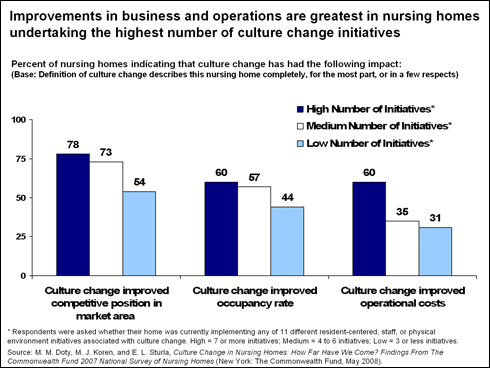The first national survey to measure "culture change" within the U.S. nursing home industry finds positive signs that long-term care facilities are beginning to transform themselves from hospital-like to home-like facilities, where residents' needs and preferences—not institutional imperatives—come first.
As reported in the Commonwealth Fund report, Culture Change in Nursing Homes: How Far Have We Come?, many nursing homes have adopted at least some practices associated with "resident-centered" care, such as involving residents in decisions related to their daily activities and giving direct-care workers a greater say in the care of their residents. At the same time, critical structural and management changes have been slow to arrive.
Although The Nursing Home Reform Act, passed in 1987, established residents' rights and quality standards for nursing homes nationwide, serious concerns remain about quality of care, and quality of life, for nursing home residents. The Commonwealth Fund 2007 National Survey of Nursing Homes was fielded to examine the penetration of the culture change movement at the national level and measure the extent to which nursing homes are adopting culture change principles and practicing resident-centered care.
According to the results, at least one-third of nursing home administrators say they are actually doing something to try to make their facilities resident-centered. For example, they are giving residents more choice in determining their daily routine and empowering frontline workers to make decisions in the day-to-day care of the residents they serve. Another quarter of homes, while they have not yet begun the transformation, at least have leaders within the facility who are committed to the principles of resident-centered care.

Little has changed, however, in other areas. For example, very few nursing homes have altered their physical environments to make facilities more homelike. Only a handful have renovated their traditional nursing units into smaller functional areas containing common community and dining areas, let alone into small home settings with a full kitchen, dining room, and living areas for 25 or fewer residents and their dedicated staff.
Still, there is much good news from the survey. From the perspective of nursing home owners who are contemplating fundamental changes, the best news is that culture change adopters see a positive impact on their bottom line. "The more nursing homes adopt reform practices, the more likely they are to report improvements in staff retention, reductions in staff absenteeism, greater market competitiveness, and higher occupancy rates," the report notes. Seventy-eight percent of nursing homes that are most engaged in culture change—those that are implementing seven or more culture change initiatives—report that culture change has improved their competitive advantage. Meanwhile, another 60 percent of this group report improved occupancy rates, and half say that staff absenteeism has decreased.

To hear more about the survey's findings and current efforts to spread culture change, view the webinar (archived) hosted on May 20 by the Picker/Commonwealth Fund Program on Quality of Care for Frail Elders and the Pioneer Network.


